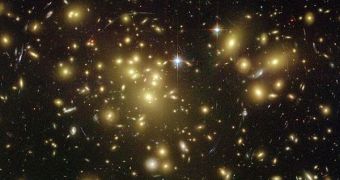A minute galaxy that neighbors the Milky Way surprised astronomers in a new study. While conducting a routine check of the object, a team discovered that the 1,000-star-large formation contained the largest amount of dark matter ever discovered in any galaxy.
The small and dim stars in the Segue 1 galaxy are about the size and mass of the Sun. Simple arithmetics indicate that 1,000 solar masses do not equal 600,000 solar masses, which is what the entire galaxy weighs.
Astrophysicists now believe that the difference is accounted for by dark matter. If that is true, then this would be the highest concentration of the stuff ever discovered in a single galaxy. Also, the proportion of dark to baryonic matter would be the highest known to date.
During the new observations sessions, the galaxy was analyzed using the 10-meter Keck II telescope, in Hawaii. It immediately became obvious that the galaxy is more than 3,400 times heavier than what its visible mass can account for.
Astronomers now plastically refer to Segue 1 as an enormous dark matter cloud that is sprinkled with a few stars. Even for a dwarf galaxy, 1,000 stars is a very small number. The Milky Way has billions.
Dark matter was never discovered by evidence. The idea that it exists was first proposed decades ago by experts who were trying to explain the large-scale behavior of galaxies. Most of these formations appeared to exert a gravitational pull that could not be accounted for through their mass alone.
The stuff is believed to be made up of weakly-interacting massive particles (WIMP), which hardly interact with normal matter other than through the force of gravity. Whenever WIMP meet, they annihilate each other, releasing energy.
One of the most important pieces of evidence researchers have that Segue 1 contains dark matter is the speeds at which the stars inside move in respect to our galaxy. Calculations showed that they should keep an average speed of 130 miles (209 kilometers) per second.
However, Keck II data reveal that some of these stars are moving at 121 miles (194 kilometers) per second, whereas other go as fast as 139 miles (224 kilometers) per second, Space reports.
“That tells you Segue 1 must have much more mass to accelerate the stars to those velocities,” Marla Geha said. The Yale University astronomer made the announcement in a recent statement.
She led the investigations team alongside colleague Joshua Simon, a researcher at the Carnegie Institution of Washington (CIW). The two provided the first evidence on the nature of Segue 1 back in 2008, but at the time they didn't have nearly as many evidences as they do now.

 14 DAY TRIAL //
14 DAY TRIAL //